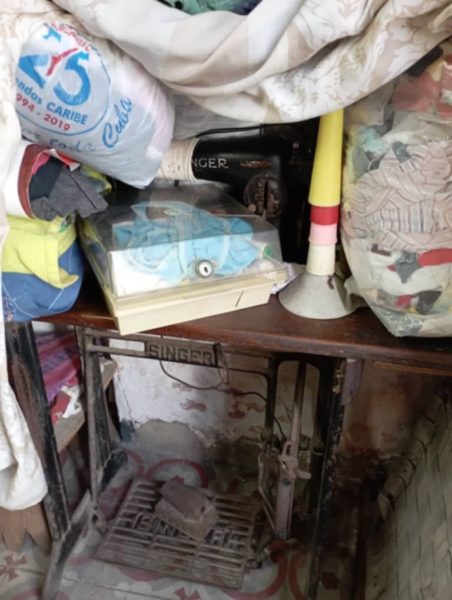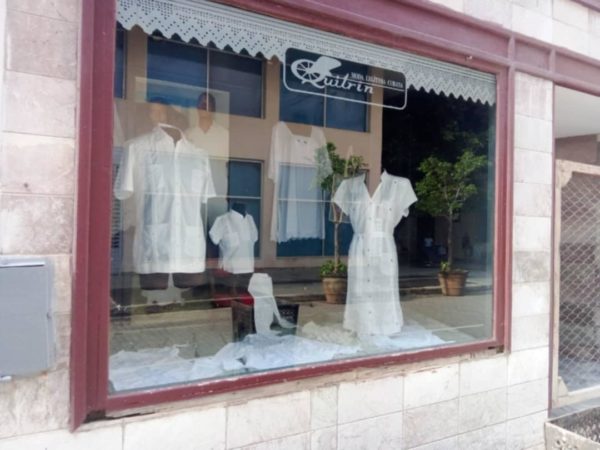
By Laura Gomez
HAVANA TIMES – Finding someone to mend a piece of clothing is very common for some everyday Cubans, although often the high prices and delays in services are limiting factors. Odalis, 56, is a seamstress who was recommended to me for fixing some pants. In her room, there are piles of clothes in the most unexpected places, like on the old Singer machine she has to clear to be able to sew.
“Don’t mind the mess,” she tells me, though it’s impossible not to notice.

I think all seamstresses are the same, aren’t they?
I don’t know, you can’t generalize. The ones I know do have their houses full of piles of clothes. I am a seamstress and a pattern maker, although I prefer sewing and embroidery. I have patterns saved from when I worked at El Quitrín, the Industrial Handicraft Development Center, patterns for all sizes. However, I barely use them; being a pattern maker takes a lot of time and the daily rush doesn’t allow me to create new pieces. Not to mention how difficult it is for me to get fabrics, as they are only sold in MLC [magnetic dollars]. Many customers bring me the materials, but I prefer sewing; it’s simpler, although a lot of clothes from customers pile up, as well as some clothes people no longer want and bring to me in case I can make use of them.
How did you start in sewing?
My first steps were here at home. My mother had a UNION make sewing machine and I had the chance to make clothing models that I saw in magazines. As a child, I fantasized about being a good seamstress and having my own clothing label. When I finished my studies as a Middle Technician in Economics, a friend told me about a course at El Quitrín. Within a year, I was one of the most advanced. There, I learned to make traditional Cuban clothes with a touch of modernity. There was a lot of competition and barely any time to socialize. At that time, the salary was very good because we were tied to production. I remember the sewing machines, their sounds in unison, the seamstresses with their eyes fixed on the stitches. Those were very good times.

Are you still there?
No. That was decades ago. I had many problems at once and decided to quit. Not only because of personal situations but because the Special Period crisis of the ‘90s was a difficult process for everyone. My late arrivals due to the transportation situation and other family problems limited me. I remember becoming a speed athlete. Sometimes I would get on any bus without knowing where it was going; other times I walked from Old Havana to Cojímar, only crossing the tunnel on the bus that also carries bicycles.
What other problems did you have that led you to leave work?
My mother got sick. She worked as a cook in a primary school. She had a work accident and never recovered. Her cervical spine was affected, and from there it was downhill until she passed away. My brother got sick with nerves. My only hope was sewing because I could do it from home.
Did any family member support you?
The only support I had was Nestor, a friend who came to my house every day. The closeness, my difficulties, and my loneliness made him not only my emotional support at that time but also my partner. However, he didn’t take the news of my pregnancy as I expected, but still, I prepared myself to accept the role of a single mother. Thanks to sewing and embroidery, I could make the entire babywear for the newborn. We have gone through a lot of hardship for many years; he grew up with limitations, but I don’t regret it; he is my blessing.
How did you take on and handle the responsibility of being a single mother?
It was and is very difficult. Nowadays, young people want to look good, have all the good things, the latest, and he knows that’s impossible. These are also times of great violence, vices, and scarcity; you have to be very attentive with young people. When he finished junior high school, he told me he wanted to be a firefighter and meet his father, and I respected his decision; mothers always want the best for their children.
He doesn’t like being scolded or advised, typical of teenagers. When he sees me crying for some reason, he doesn’t know what to do to comfort me. How much I would like to give him the best, but these are difficult times. I have worked in cafeterias and small stores. In the last one, I was doing well, but I had to leave because the owner started harassing me, almost in front of his wife who worked with us. Beyond how unpleasant it was, it was a ticking time bomb. So, I left. I returned to sewing.
Tell me about the time you dedicate to sewing. Do you listen to music while you work?
As you can see, there’s no TV or radio in my house. I often ask my neighbor for the time, and she updates me on the news. I notice that I have regressed. I don’t function as before. I have many piles of customers’ clothes from almost four years ago; maybe they are no longer in the country, or they just left them with me. There are clothes that I don’t even remember who the owners are. What I do most these days is repair school uniforms, kitchen cloths, doilies, and clothes that people leave already paid for. When the pandemic started, I made and sold many masks and even though those were hard years, I had some money every day. There are days when I wake up wanting to sew, motivated, I finish several pieces, but on others, even the sound of the machine pedal bothers me. I eat very little, trying to save the minimum I get for when my son, who is doing his military service, comes.
Do you think this profession of seamstress could disappear?
I don’t think so. Modern sewing machines have many more operations and that helps save time and especially effort. There will always be seamstresses because there will always be clothes to wear, just as there will always be cobblers for shoes.
How do you get the materials?
They are very difficult to obtain. There are MLC stores that sell them, but at a very high [dollarized] price and what I charge for the work I finish is very little: 100 pesos (about 30 cents USD) for each piece I fix. Now most of my work is mending, hemming, and taking in clothes. I don’t like to overcharge clients because I know how the situation is, and what people earn goes to food. Despite everything, I have a reserve of threads, needles, and elastic for when needed. My brother sharpens my scissors and that’s one less problem. The SINGER sewing machine replaced the UNION my mother had because the crank got rusty, and it was very hard for me to operate the pedal.
Would you feel more motivated with a modern machine?
Of course. Old sewing machines are very good, made with high-quality materials, but they are also more limited; they can’t sew heavy fabrics, for example. Modern ones, most are plastic and metal alloys, very easy to handle. I would like to have an electric pedal machine, with stitch designs, threads of all colors, and also a room with music and hangers to place clients’ clothes. But I would also like to have the money to give my son everything he needs. I assure you, I would be the happiest seamstress in Havana.
Read more from Cuba here on Havana Times.




